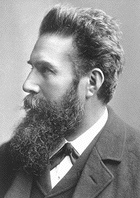
1845 - 1923
Ršntgen spent most of his years researching physics, thermology, mechanics, and electricity. Although he made some great discoveries in all these fields, his greatest invention was the discovery of a short-wave ray in 1895, which we know now as X-rays. Some other things he studied were the heats of gasses and fluids, the characteristics of quartz, the modification of the planes of polarized light by electromagnetic influences, the variations in the functions of temperature, the compressibility of water and other fluids, and the event of the spreading of oil drops on water.
Throughout his life, Ršntgen received many honors. Even though he was well known for his skills, he remained a modest man who never sought honors or money for his research and projects. For instance, he declined various titles and jobs, and donated money to his university that he received from the Nobel Prize. He also refused to take patents on his work, so that the whole world could benefit from his work. Aside from his modesty and generosity, he did accept honors and awards including the first Nobel Prize, streets being named after him, medals, honorary doctorates, memberships into societies around the world, the honorary degree of Doctor of Medicine, and the Ršntgen Memorial (located in Wźrzburg, Germany), and a variety of other awards. He also taught at German schools, and became the chair of physics at the University of Geissen. Some other interests and hobbies that he enjoyed, were spending time in the outdoors, vacations at his summer home at Weilheim (Bavarian Alps) entertaining friends and family, and mountaineering.
Wilhelm Conrad Ršntgen died in 1923. Throughout his life, he was awarded 85 honors and awards, with the first Noel Prize in physics as one.